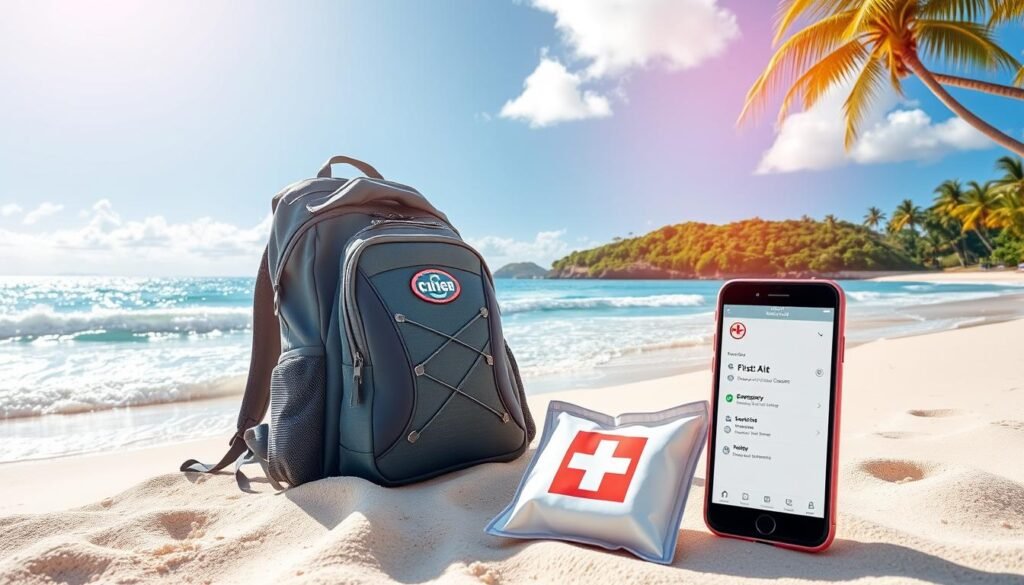As you plan your next adventure, whether it’s a weekend getaway or an international excursion, one important consideration often overlooked is travel insurance. While it may seem like an additional expense, this essential coverage can provide invaluable protection and peace of mind when unexpected events derail your travel plans. In this comprehensive guide, we’ll explore the importance of travel insurance, the various types of coverage available, and how to determine if it’s a necessary investment for your upcoming trips.
This post may contain affiliate links. If you make a purchase or booking through one of our links, we may earn a small commission. As an Amazon Associate, I earn from qualifying purchases. The content on this website was created with the help of AI.
Key Takeaways
- Travel insurance provides essential protection for unforeseen events, such as trip cancellations, medical emergencies, and lost or stolen belongings.
- Understanding the different types of coverage, from trip cancellation to medical emergencies, can help you choose the right policy for your needs.
- Evaluating the cost versus the potential benefits of travel insurance can help you make an informed decision about whether it’s worth the investment.
- Reviewing the fine print and understanding the exclusions in a travel insurance policy is crucial to ensure you have the coverage you expect.
- In some cases, you may be able to skip travel insurance, such as when your credit card or existing health insurance provides adequate coverage.
What Is Travel Insurance and Why It Matters
Travel insurance is a crucial safeguard for those embarking on journeys, providing protection and peace of mind against the unexpected. Whether you’re planning a domestic road trip or an international adventure, understanding the basics of travel insurance can help you navigate the complexities of travel risk management.
Types of Coverage Available
Travel insurance policies typically offer a range of coverage options, including:
- Trip cancellation and interruption protection
- Emergency medical and dental care
- Medical evacuation and repatriation services
- Lost, stolen, or damaged baggage and personal belongings
- Travel delay and missed connection coverage
Basic Protection Components
At the core of travel insurance are the basic protection components that safeguard travelers. These include:
- Medical coverage for unexpected illnesses or injuries
- Reimbursement for cancelled or interrupted trips
- Protection against lost, stolen, or damaged luggage and personal items
Risk Management While Traveling
Travel insurance is a critical tool for managing the risks associated with travel travel insurance basics. It provides a safety net in the event of unforeseen circumstances, allowing travelers to focus on the journey and minimize the financial impact of travel disruptions. By understanding the travel risk management aspects of travel insurance, travelers can make informed decisions and ensure they are adequately protected.
“Travel insurance is the ultimate travel companion, protecting your investment and providing peace of mind on the road.”
Common Travel Insurance Coverage Options
When it comes to travel insurance, understanding the standard coverage options can help you make an informed decision. From trip cancellation to baggage protection, these are the most common travel insurance benefits you’ll find in a typical policy:
- Trip Cancellation and Interruption Coverage – This covers the cost of your trip if you need to cancel or cut it short due to unexpected events, such as illness, injury, or even natural disasters.
- Baggage and Personal Items Coverage – Protects you if your luggage is lost, stolen, or damaged during your travels, reimbursing you for the replacement cost.
- Travel Delay Coverage – Provides reimbursement for additional expenses, like meals and accommodations, if your trip is delayed for a covered reason, such as bad weather or a mechanical breakdown.
- Emergency Medical and Evacuation Coverage – Covers the cost of emergency medical treatment and transportation if you become ill or injured while traveling, including medical evacuation to an appropriate facility.
These are just a few of the standard coverage options typically included in travel insurance policies. The specific details and limits can vary depending on the provider and the plan you choose, so it’s important to carefully review the policy details to ensure you get the coverage you need.
| Coverage Type | Typical Inclusion | Average Limits |
|---|---|---|
| Trip Cancellation | Reimbursement for pre-paid, non-refundable trip costs | Up to 100% of trip cost |
| Baggage and Personal Items | Reimbursement for lost, stolen, or damaged items | $1,000 – $3,000 per person |
| Travel Delay | Reimbursement for additional expenses, such as meals and accommodations | $200 – $500 per day, up to $2,000 total |
| Emergency Medical | Coverage for emergency medical treatment and transportation | $50,000 – $500,000 per person |
By understanding these common travel insurance coverage options, you can better evaluate which policy best fits your needs and budget, ensuring you have the protection you need for your next trip.

Understanding Travel Medical Insurance Coverage
When planning an international trip, it’s crucial to consider the importance of travel medical insurance. This type of coverage can provide a vital safety net, protecting you from the potentially astronomical costs of emergency medical treatment and evacuation while abroad.
Emergency Medical Treatment Abroad
Travel medical insurance typically covers the expenses associated with emergency medical care received in a foreign country. This can include hospitalization, doctor’s visits, prescription medications, and even necessary dental work. By having this coverage, you can rest assured that you won’t be saddled with hefty bills if you require unexpected medical attention during your trip.
Medical Evacuation Coverage
One of the most valuable aspects of travel medical insurance is its provision for medical evacuation. If you suffer a serious injury or illness that requires transportation to a more appropriate medical facility, your policy can cover the cost of a medical-grade flight or other transportation. This ensures you receive the care you need, even in remote or underserved regions.
Pre-existing Conditions Clauses
When evaluating travel medical insurance policies, it’s essential to understand the fine print regarding pre-existing conditions. Many policies may exclude or limit coverage for pre-existing medical issues, so it’s important to read the policy details carefully and disclose any relevant health conditions to your insurer. Some policies may offer coverage for pre-existing conditions, but often at an additional cost.
Investing in comprehensive overseas medical coverage and emergency evacuation insurance can provide invaluable peace of mind and financial protection during your travels. By understanding the key components of travel medical insurance, you can make an informed decision and ensure you’re well-prepared for any medical emergencies that may arise.
| Coverage | Description | Importance |
|---|---|---|
| Emergency Medical Treatment | Covers expenses for unexpected medical care while abroad | Protects you from potentially high out-of-pocket costs |
| Medical Evacuation | Provides transportation to an appropriate medical facility if needed | Ensures you receive the necessary care, even in remote locations |
| Pre-existing Conditions | May exclude or limit coverage for pre-existing medical issues | Requires careful review of policy details to understand coverage limitations |
Trip Cancellation and Interruption Protection
When planning a trip, one of the most critical considerations is protecting your travel investment. Trip cancellation insurance and travel interruption coverage are essential travel protection tools that can safeguard your vacation from unexpected circumstances.
These policies typically cover a wide range of scenarios that could disrupt your travel plans, including:
- Illness or injury of the policyholder or a close family member
- Flight cancellations or delays due to weather or mechanical issues
- Natural disasters or civil unrest at your destination
- Unexpected job loss or work obligations
- Theft of passport, travel documents, or luggage
In the event of a covered cancellation or interruption, these policies can provide reimbursement for pre-paid, non-refundable expenses, such as airfare, hotel stays, and tour bookings. Coverage limits and exclusions may vary, so it’s essential to carefully review the policy details to understand the scope of protection.

While the cost of trip cancellation and interruption coverage may seem like an added expense, the peace of mind and financial protection it provides can be invaluable. Especially for larger, more expensive trips, these policies can help you recoup your losses and ensure you don’t lose your entire travel investment due to unforeseen circumstances.
Ultimately, trip cancellation insurance and travel interruption coverage are essential considerations for any traveler looking to safeguard their vacation plans and mitigate the risks associated with the unpredictable nature of travel.
Guide to Travel Insurance: Choosing the Right Policy
Selecting the most suitable travel insurance policy can be a daunting task, but with the right guidance, you can ensure you’re adequately protected. This section will provide you with valuable tips on comparing policies, analyzing cost versus coverage, and understanding the fine print to make an informed decision.
Policy Comparison Tips
When comparing travel insurance policies, it’s crucial to consider the following factors:
- Coverage limits for medical emergencies, trip cancellation, and other key benefits
- Exclusions and limitations that may restrict your coverage
- Deductibles and co-payments that you’ll be responsible for
- Reputation and customer satisfaction ratings of the insurance provider
Cost vs Coverage Analysis
While the cost of a travel insurance policy is important, it’s equally crucial to examine the level of coverage it provides. Don’t simply choose the cheapest option – instead, focus on finding a policy that offers the right balance of affordability and comprehensive protection for your specific travel needs.
Reading the Fine Print
Before purchasing a travel insurance policy, be sure to read the fine print carefully. This will help you understand the policy’s terms, conditions, and exclusions, ensuring that there are no surprises should you need to file a claim. Pay close attention to any pre-existing medical condition clauses, activity limitations, and the claims process requirements.
“Investing in the right travel insurance policy can provide peace of mind and financial protection during your travels. Take the time to carefully evaluate your options to ensure you’re getting the coverage you need.”
When You Can Skip Travel Insurance
While travel insurance is often recommended for its comprehensive coverage and protection, there are certain situations where you may be able to skip it and save some money. Understanding when travel insurance alternatives or self-insuring travel can be a viable option is key to making an informed decision.
One scenario where travel insurance may not be necessary is if you have sufficient coverage through your credit card benefits or existing health insurance plan. Many credit card companies offer travel-related protections, such as trip cancellation, delay, and baggage coverage, that could negate the need for a separate travel insurance policy. Similarly, your regular health insurance may provide adequate coverage for medical emergencies while you’re abroad, eliminating the requirement for a travel medical insurance plan.
Another instance where you may not need travel insurance is for short, domestic trips or low-cost getaways. If the financial risk of your trip is relatively low, the cost of travel insurance may outweigh the potential benefits. In these cases, self-insuring travel by setting aside a small emergency fund could be a more practical solution.
It’s important to carefully review the details of your credit card benefits, health insurance plan, and the specific requirements of your trip before deciding to forgo travel insurance. Assessing the potential risks and weighing the cost of coverage against the potential financial impact can help you make an informed decision that aligns with your travel needs and budget.
| Travel Insurance Alternatives | When to Consider |
|---|---|
| Credit Card Travel Benefits | For trips where your credit card offers adequate coverage for cancellation, delays, and baggage |
| Existing Health Insurance | For trips where your health plan provides sufficient medical coverage abroad |
| Self-Insuring Travel | For low-cost, short domestic trips where the financial risk is relatively low |

By understanding the travel insurance alternatives available and assessing the risks of your specific trip, you can make an informed decision on whether purchasing travel insurance is necessary or if self-insuring travel can provide adequate protection.
How to File a Travel Insurance Claim
When it comes to the travel insurance claims process, understanding the required documentation, typical timelines, and common reasons for claim rejections can make all the difference in securing a successful payout. By familiarizing yourself with the ins and outs of this process, you can navigate it with confidence and increase your chances of a positive outcome.
Required Documentation
To file a travel insurance claim, you’ll need to gather a variety of documents, including:
- Proof of travel, such as airline tickets, hotel receipts, or boarding passes
- Receipts for any expenses you’re claiming, such as medical bills or trip cancellation costs
- A copy of your travel insurance policy
- A detailed account of the incident or event that led to your claim
- Any supporting documentation, such as police reports or medical records
Claims Process Timeline
The timeline for processing a travel insurance claim can vary, but typically it takes between 4-6 weeks to receive a decision. During this time, the insurance provider will review your claim and supporting documentation to determine the validity and extent of coverage. It’s important to be patient and responsive to any requests for additional information or clarification.
Common Claim Rejections
While most valid travel insurance claims are approved, there are a few common reasons why a claim may be rejected:
- Lack of documentation – Failing to provide the required paperwork can result in a claim being denied.
- Pre-existing medical conditions – Many policies exclude coverage for pre-existing conditions, so it’s crucial to understand the fine print.
- Missed deadlines – Claims must be filed within a specific timeframe, usually 30-60 days, so be sure to submit your claim promptly.
- Excluded activities – Certain high-risk activities, such as extreme sports, may not be covered under a standard travel insurance policy.
By familiarizing yourself with the travel insurance claims process and claim documentation requirements, you can maximize your chances of a successful claim and ensure that your travel investment is protected.
International Travel Insurance Requirements
Traveling abroad can be an exciting adventure, but it’s important to ensure you have the mandatory travel insurance coverage required by your destination country. Many countries around the world have specific country-specific requirements when it comes to travel insurance, and failing to meet these standards could result in denied entry or costly complications during your trip.
To help you prepare for your international travel, here’s a closer look at some of the key mandatory travel insurance requirements you may encounter:
- European Union (EU) countries often require travelers to have comprehensive medical coverage, including provisions for emergency medical treatment and repatriation expenses.
- Several countries in Asia, such as Thailand, Vietnam, and Indonesia, mandate that visitors have travel insurance that covers COVID-19-related medical expenses and potential quarantine costs.
- The United Arab Emirates (UAE) requires all visitors to have travel insurance that provides a minimum of $50,000 in medical coverage and $150,000 in emergency medical evacuation benefits.
- Many Caribbean nations, including Jamaica, Bahamas, and Aruba, have implemented country-specific requirements for travel insurance coverage, often focusing on medical emergencies and trip cancellation/interruption protection.
It’s crucial to research the mandatory travel insurance policies of your destination country well in advance of your trip to ensure you have the necessary coverage. Failing to comply with these country-specific requirements could lead to denied entry, hefty fines, or other complications that could put a damper on your international adventure.

Top Travel Insurance Providers and Comparison
Choosing the right travel insurance provider can be a crucial decision for your next adventure. To help you make an informed choice, let’s explore the top travel insurance companies and compare their key offerings.
Customer Service Rankings
When it comes to travel insurance, the level of customer service can make all the difference. According to industry reviews, the best travel insurance companies for customer satisfaction include:
- Allianz Travel Insurance
- Travel Guard
- Travelex Insurance Services
Price Points and Value
Securing the right travel insurance coverage doesn’t have to break the bank. Here’s a quick comparison of the average price points and value offered by some of the top best travel insurance companies:
| Provider | Average Cost | Value for Money |
|---|---|---|
| World Nomads | $40-$100 | Excellent |
| Squaremouth | $50-$150 | Good |
| TravelSafe | $30-$80 | Very Good |
Coverage Specializations
Not all travel insurance providers are created equal. Some excel in specific areas of coverage, making them better suited for certain types of travelers. Consider the following specializations:
- Adventure Sports Coverage: World Nomads
- Pre-existing Condition Waivers: Allianz Travel Insurance
- Cancel for Any Reason: Travelex Insurance Services
By understanding the strengths and provider comparison of these top travel insurance companies, you can make an informed decision that aligns with your specific travel needs and budget.
Conclusion
As you embark on your next travel adventure, consider the valuable insights from this comprehensive guide on travel insurance. The decision to purchase coverage is not one to be taken lightly, as it can significantly impact your overall travel experience and financial well-being. By understanding the travel insurance decision-making process and the various insurance benefits summary, you can make an informed choice that aligns with your specific needs and budget.
Throughout this guide, we’ve explored the essential components of travel insurance, including medical coverage, trip cancellation/interruption protection, and risk management strategies. Recognizing the unique challenges and potential risks associated with international travel, we’ve highlighted the importance of selecting the right policy to safeguard your investments and ensure a worry-free journey.
Ultimately, the decision to acquire travel insurance is a personal one, influenced by factors such as your travel itinerary, health status, and level of risk tolerance. By carefully weighing the pros and cons, and taking the time to read the fine print, you can make an informed decision that provides the coverage and peace of mind you need. As you plan your next adventure, remember that a well-informed travel insurance decision can be the key to unlocking an unforgettable and stress-free experience.



